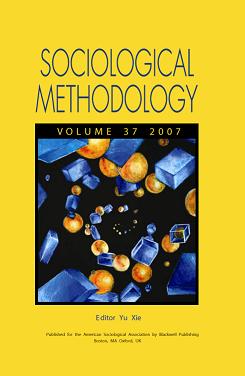
| Editor’s Introduction | ||
| Yu Xie | ||
This is the second volume of Sociological Methodology produced under my editorship. Volume 37, our first volume, came out in the fall of 2007. The experience of producing that volume was invaluable in producing this one, for which we processed over twice as many submissions. All of our editorial decisions were based on highly selective recommendations of peer reviewers.
Altogether, we considered 46 articles plus 5 comments for volume 38, of which we chose to publish 9, plus the comments relating to one of them. Seven more articles received revise-and-resubmit status, and we hope revised versions of some of these may appear in volume 39. Overall, we found the quality of submitted manuscripts to be extremely high.
IIn this, our second volume of Sociological Methodology, we have again grouped the papers in four sections in which they seem to naturally fit. We begin with a symposium on implication analysis, leading off with “Implication Analysis: A Pragmatic Proposal for Linking Theory and Data in the Social Sciences” by Stanley Lieberson and Joel Horwich. Following the article are the remarks of five commentators -- Glenn Firebaugh, Jack Goldstone, Mark Mizruchi, Burton Singer, and Charles Tilly – plus Lieberson and Horwich’s response to their comments. At the core of the debate is the question of how empirical data should be marshaled in response to the need to test theory, and whether or not Lieberson and Horwich’s proposal represents something significantly different from the best practices already being used in sociology. These scholarly exchanges should be of interest to many readers of Sociological Methodology. As this volume was going to press, we were saddened to hear of the death of one of the commentators, Chuck Tilly, and we are glad to have been able to publish one of his final works. Chuck was known not only as an extraordinary scholar and author but also as a prolific reviewer, and we honor his service to our discipline.
The second section of the volume focuses on data collection and data quality. It includes two papers. In “Measurement Error in Stylized and Diary Data on Time Use,” Man Yee Kan and Stephen Pudney report a study of measurement errors in time use data, comparing standard survey-based estimates against diary estimates. In “Validation of a Diary Measure of Children’s Physical Activities,” Sandra L. Hofferth, Gregory J. Welk, Margarita S. Treuth, Suzanne M. Randolph, Sally C. Curtin, and Richard Valliant revisit the same problem of time use, comparing time diary data with those measured using a physical instrument, the accelerometer.
Social network is one of the key research areas in contemporary sociology. The third section of this volume contains two methodological contributions to network analysis. In “A Relational Event Framework for Social Action,” Carter T. Butts proposes a general framework in which to accommodate complex structures of dependence among observed events in social settings. In “Modeling Diffusion of Multiple Innovations via Multilevel Diffusion Curves: Payola in Pop Music Radio,” Gabriel Rossman, Ming Ming Chiu, and Joeri Mol combine multilevel analysis with diffusion curve analysis, applied to an example of bribery in pop radio.
Finally, we conclude the volume with four papers on statistical methods. In “A Diagnostic Routine for the Detection of Consequential Heterogeneity of Causal Effects,” Stephen L. Morgan and Jennifer J. Todd focus on the detection of heterogeneous treatment effects in causal inference, providing a simple nine-step routine to evaluate the implicit weighting of regression results. Kazuo Yamaguchi proposes four different mixture models for categorical outcome variables in panel data in his article, “Four Useful Finite Mixture Models for Regression Analyses of Panel-Data with a Categorical Dependent Variable.” In “Outliers, Leverage Observations and Influential Cases in Factor Analysis: Minimizing Their Effect Using Robust Procedures,” Ke-Hai Yuan and Xiaoling Zhong report a study of the effects of leverage observations and outliers in factor analysis. Finally, Jeroen K. Vermunt, Joost R. van Ginkel, L. Andries van der Ark, and Klaas Sijtsma propose latent class analysis for the multiple imputation of incomplete categorical data in “Multiple Imputation of Incomplete Categorical Data Using Latent Class Analysis.”
Although we were not able to publish every manuscript we received, we wish to thank all those who submitted articles for our consideration as well those who reviewed them or otherwise assisted with the review process. I wish to extend my special thanks to Cindy Glovinsky, my managing editor, Debra Hevenstone and Haiyan Zhu, my editorial assistants, Stephanie Magean, our copy editor, and Raissa Xie, whose artwork appears on the cover. Thanks also to Jennifer Scarano and the staff at Blackwell Press who worked on this volume and to Karen Edwards and the American Sociological Association for their continuing support. We also wish to acknowledge generous financial support from the Department of Sociology, the Survey Research Center, and the Population Studies Center, at the University of Michigan.
